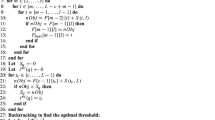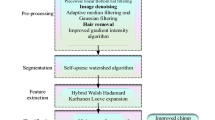Abstract
The main focus of this paper is to improve the performance of the texture model Optimized Local Ternary Patterns (OLTP), which is known as one of the successful variants of the texture model Local Binary Patterns (LBP), a well known method for texture analysis and its applications. Generally preprocessing is used in digital image processing for reducing the unwanted noise and disturbances in such a way that it improves the quality of the image. Preprocessing not only removes the distortions but also enhances the features of the image for further processing. To achieve better recognition accuracy, the texture model OLTP was combined with a preprocessing method that uses nonlinear diffusion method as a preprocessing tool in this paper, with the hope that this idea will surely improve the local feature description and texture classification process. This nonlinear diffusion method uses two newly developed edge stopping functions for preprocessing. This proposed method is tested with two standard texture datasets namely Brodatz Dataset and Usptex dataset. The results show that the use of the preprocessing step really improved the texture classification accuracy.






Similar content being viewed by others
References
Backes AR, Casanova D, Bruno OM (2012) Color texture analysis based on fractal descriptors. Pattern Recogn 45(5):1984–1992
Bhateja V, Mishra M, Urooj S (2016) Non-linear polynomial filters for edge enhancement of mammogram lesions. Comput Methods Prog Biomed 129:125–134
Brodatz P (1966) Textures: a photographic album for artists and designers. Dover Publications, New York
Cohen FS, Fan Z, Patel MA (1991) Classification of rotated and scaled textured images using Gaussian Markov random field models. IEEE Trans Pattern Anal Mach Intell 13(2):192–202
Cula OG, Dana KJ (2001) Compact representation of bidirectional texture functions. IEEE Conference on Computer Vision and Pattern Recognition, Kauai, HI, USA
Heikkila M, Pietikainen M, Schmid C (2006) Description of interest regions with center-symmetric local binary patterns. Pattern Recogn 42(3):425–436
Jain AK (1996) Learning texture discrimination masks. IEEE Trans Pattern Anal Mach Intell 18(2):195–205
Jain AK, Duin RPW, Mao J (2000) Statistical pattern recognition: a review. IEEE Trans Pattern Anal Mach Intell 22(1):4–37
Kim K, Keechul J, Park S, Kim H (2002) Support vector machines for texture classification. IEEE Trans Pattern Anal Mach Intell 24(11):1542–1550
Laine A, Fan J (1993) Texture classification by wavelet packet signatures. IEEE Trans Pattern Anal Mach Intell 15(11):1186–1191
Ma WY, Manjunath BS (1998) A texture thesaurus for browsing large aerial photographs. J Am Soc Inf Sci 49(7):633–648
Madasamy Raja G, Sadasivam V (2013) Optimized local ternary patterns: a new texture model with set of optimal patterns for texture analysis. J Comput Sci 9(1):1–14
Madasamy Raja G, Sadasivam V (2014) Segmentation of multi-textured images using optimized local ternary patterns. Int J Comput Appl 95(16):22–29
Neiva MB, Guidotti P, Bruno OM (2018) Enhancing LBP by preprocessing via anisotropic diffusion. Int J Mod Phys C 29(8)
Ojala T, Pietikäinen M, Harwood D (1996) A comparative study of texture measures with classification based on feature distributions. Pattern Recogn 29(1):51–59
Ojala T, Pietikäinen M, Mäenpää T (2002) Multiresolution gray-scale and rotation invariant texture classification with local binary patterns. IEEE Trans Pattern Anal Mach Intell 24(7):971–979
Oliver CJ (2000) Rain forest classification based on SAR texture. IEEE Trans Geosci Remote Sens 38(2):1095–1104
Panjwani DK, Healey G (1995) Markov random field models for unsupervised segmentation of textured color images. IEEE Trans Pattern Anal Mach Intell 17(10):939–954
Perona P, Shiota T, Malik J (1994) Anisotropic diffusion. In: terHaarRomeny BM (ed) Geometry-driven diffusion in computer vision. Kluwer Academic Publishers, Netherland, pp 72–92
Perumal S, Velmurugan T (2018) Preprocessing by contrast enhancement techniques for medical images. Int J Pure Appl Math 118(18):3681–3688
Prabhu V, Kuppusamy PG, Karthikeyan A et al (2018) Evaluation and analysis of data driven in expectation maximization segmentation through various initialization techniques in medical images. Multimed Tools Appl 77:10375
Raghu PP, Poongodi R, Yegnanarayana B (1997) Unsupervised texture classification using vector quantization and deterministic relaxation neural network. IEEE Trans Image Process 6(10):1376–1387
Ramsey M, Chen H, Zhu B, Schatz B (1999) A collection of visual thesauri for browsing large collections of geographic images. J Am Soc Inf Sci 50(9):826–834
Rao A, Lohse G (1996) Towards a texture naming system: identifying relevant dimensions of texture. Vis Res 36(11):1649–1669
Tan X, Triggs B (2010) Enhanced local texture feature sets for face recognition under difficult lighting conditions. IEEE Trans Image Process 19(6):1635–1650
Wei L-S, Gan Q, Ji T (2018) Skin disease recognition method based on image color and texture features. Comput Math Methods Med 1–10
Author information
Authors and Affiliations
Corresponding author
Additional information
Publisher’s note
Springer Nature remains neutral with regard to jurisdictional claims in published maps and institutional affiliations.
Rights and permissions
About this article
Cite this article
Madasamy Raja, G., Thaha, M., Latha, R. et al. Texture classification using optimized local ternary patterns with nonlinear diffusion as pre-processing. Multimed Tools Appl 79, 3831–3846 (2020). https://doi.org/10.1007/s11042-019-7197-0
Received:
Revised:
Accepted:
Published:
Issue Date:
DOI: https://doi.org/10.1007/s11042-019-7197-0




